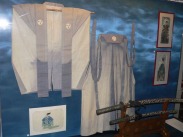Samurai Clothing

For Samurais the basic 'everyday' wardrobe was the kimono, which for men normally consisted of an outer and inner layer. Heavier kimonos were worn in the winter, while lighter ones usually made our of fabrics such as finer silk were worn in the summer. Traditionally on the 1st day of the Fourth Month or there was a ceremonial day where winter kimonos were exchanged for their summer counterparts. A samurai's kimono would normally be made of silk, a material considered superior to cotton and hemp not only for its feel and appearance, but for it's relative coolness in the hot Japanese summer. Naturally, the quality of a kimono a given samurai might wear largely depended on his personal station and income, though, at least prior to the Edo Period, there were no hard and fast rule in this regard. Hojo Soun, for instance, touches on the matter of clothing in his 21 Articles, "Don't think your swords and clothing should be as good as those of other people. Be content as long as they don't look awful. Once you start acquiring what you don't have and become even poorer, you'll become a laughingstock."1 Exceptionally bright colors and outlandish patterns were typically avoided or sneered upon as a show of immodesty or conceit. On the same token, women of samurai families tended to wear kimono layers and colors dependant upon the station and/or power of their husband. Samurai children were dressed rather flamboyantly, and a more subdued appearance was one of the results of the coming-of-age ceremony. Older samurai tended towards shades of gray or brown, in keeping with their dignified age.
Underneath the kimono, a loincloth (fundoshi) was worn, of which there were two varieties. The first was essentially a wrap that resembled a diaper (familiar to anyone who has witnessed or seen footage of some of modern Japan's more esoteric festivals); the other type (usually worn under armor) was a long piece of material worn down the front of the body. A loop slung around the neck fastened the top of the loincloth while the other end was pulled up around the other side of the abdomen and tied around the front of the lower waist with cords. Samurai had the option of wearing socks, called tabi, which included a space to separate the big toe from the other toes (to facilitate the wearing of sandals). Tabi worn in an everyday capacity were normally white and were tailored to the season.
The footwear worn generally consisted of sandals (waraji) and wooden clogs (geta). The sandals were made from various sorts of material, including straw, hemp, and cotton thread. The clogs were generally associated with the lower classes although samurai wore them from time to time.
Between the 12th and 17th Century, the hitatare style of dress was popular. Unlike the kimono, which was much more common, the hitatare was a two-piece costume, though comparably flowing and ample. The hitatare were normally adorned with the crest of their immediate family or clan. In the case of relatives of the lord, the crest of the daimyô or shugo were worn.
Generally, the samurai's swords were normally thrust through a belt worn wrapped around the waist and tied in front.
The hitatare could be worn 'half-off', that is, the upper half was allowed to hang about the waist, and this would be done when engaging in impromptu wresting matches or, occasionally, shows of swordsmanship or archery.
By the Edo Period, the hitatare gave way to the kamishimo. The kamishimo consisted of a two-piece costume worn over a kimono. This is probably the most well known samurai dress. The upper piece was called the kataginu, and was essentially a sleeveless jacket or vest with exaggerated shoulders. Alternatively, a long sleeved coat, the haori , could be worn, especially when traveling or in bad weather. The lower piece was the hakama: wide, flowing trousers somewhat like those found in the older hitatare. The kamishimo would normally be composed of the same material, and was more likely to reflect the status of its wearer than not.
The samurai's hair was an important part of his appearance. The traditional hairstyle was the topknot, which wasn’t exclusive only to the samurai. There were numerous styles of topknots by the Edo Period. One style, the chasen-gami, was produced by wrapping a piece of string around the length of the topknot, producing a spray of hair at the end that resembled a tea wisk. The topknot would then either be worn back or forward, hanging over the center of the head. Another style, the mitsu-ori, was popular in the later 16th Century. The hair was well oiled and formed into a queue and folded forward on the head, then back again, and was tied in place.
Facial hair was common prior to the Edo Period, and was a show on manliness on the part of the wearer. Moustaches were popular, and among generals these could become quite distinctive. Beards, which was usually thin, were also worn particularly because they made wearing helmet cords more comfortable.
For headgear out of armor, powerful samurai would wear an eboshi, which is a cap of black silk gauze stiffened with a black lacquered paper lining. The cap was held in place either by a white cord, or was pinned to the samurai's topknot. The size and shape of the cap was largely dependant on the samurai's rank, though the use of eboshi was reserved for only the most formal of events by the 16th Century.
